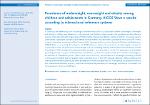Prevalence of underweight, overweight and obesity among children and adolescents in Germany. KiGGS Wave 2 results according to international reference systems
Schienkiewitz, Anja
Damerow, Stefan
Schaffrath Rosario, Angelika
In Germany, the reference system according to Kromeyer-Hauschild is usually used to define underweight, overweight
and obesity in children and adolescents. International classification systems to describe prevalence are the reference
systems of the World Health Organization (WHO) and the International Obesity Task Force (IOTF). This article reports
underweight, overweight and obesity prevalences among children and adolescents according to WHO and IOTF criteria
using data from the second wave of the German Health Interview and Examination Survey for Children and Adolescents
(KiGGS Wave 2, 2014-2017). According to the WHO reference system, the prevalence of underweight among 5- to
17-year-olds is 1.6%, the prevalence of overweight is 26.3% (including obesity) and the prevalence of obesity is 8.8%.
According to IOTF, the prevalence of underweight among 3- to 17-year-olds is 10.0%. The prevalence of overweight
(including obesity) is 19.3% and the prevalence of obesity is 4.7%. From a public health point of view, underweight as
an indicator of malnutrition plays a rather minor role in Germany. The prevalence of overweight according to WHO
is three quarters higher and one quarter higher according to IOTF than the national reference. When comparing the
international reference systems, the WHO prevalence is one third higher than IOTF prevalence. According to national
and international reference systems, no further increase in the prevalence of overweight and obesity is observed, but
the prevalence remain at a high level.
Dateien zu dieser Publikation
Anmerkungen
Die deutsche Version des Artikels ist verfügbar unter: http://doi.org/10.17886/RKI-GBE-2018-080

